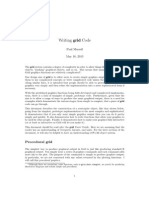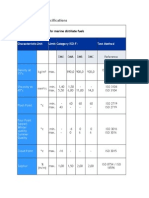0 ratings0% found this document useful (0 votes)
35 viewsPlotting With Ggplot: Install - Packages ("Ggplot2") Library (Ggplot2)
The document discusses using the ggplot2 package in R for creating publication-ready graphics. It introduces some basic functions in ggplot2 like qplot() and ggplot() for generating different types of plots like scatter plots, line graphs, density plots, and bubble charts from sample datasets. Specific geoms like geom_point(), geom_line(), and aesthetics like color and size mappings are demonstrated. Producing interactive and informative visualizations with ggplot2's comprehensive theming capabilities is emphasized.
Uploaded by
sunifeb128075Copyright
© © All Rights Reserved
Available Formats
Download as DOCX, PDF, TXT or read online on Scribd
0 ratings0% found this document useful (0 votes)
35 viewsPlotting With Ggplot: Install - Packages ("Ggplot2") Library (Ggplot2)
The document discusses using the ggplot2 package in R for creating publication-ready graphics. It introduces some basic functions in ggplot2 like qplot() and ggplot() for generating different types of plots like scatter plots, line graphs, density plots, and bubble charts from sample datasets. Specific geoms like geom_point(), geom_line(), and aesthetics like color and size mappings are demonstrated. Producing interactive and informative visualizations with ggplot2's comprehensive theming capabilities is emphasized.
Uploaded by
sunifeb128075Copyright
© © All Rights Reserved
Available Formats
Download as DOCX, PDF, TXT or read online on Scribd
You are on page 1/ 3
Plotting with ggplot
Umesh P., SilpaBhaskaran
Dept. of Computational Biology and Bioinformatics, University of Kerala
R package is nowadays used widely for generating dynamic and interactive graphics because of
its capability to produce wide variety of graphs out of the input data. Several packages are
available with R to create such high resolution, publication ready images. ggplot2 is one of the
most popular packages in R that helps to generate beautiful graphics. Apart from the R's plot()
function, ggplot2 allows you to create more complex graphs and plots. ggplot2 allows
composing a set of independent components- such as scales and layers, in different ways to get
variety of graphs. ggplot2 helps us to create hassle-free, quality plots in seconds without
compromising the accuracy. It also takes care of the formatting requirements of the plot and
provides a comprehensive theming system that complements the plots in appearance. In this
issue we are discussing some basic commands used in ggplot2 for producing interactive
graphics.
To make ggplot2 available for our application, first install the package and load it into R
environment:
install.packages("ggplot2")
library(ggplot2)
Now, let us look into qplot( ) which is one of the basic plotting function in the ggplot2 package.
Consider the following data of accident cases occurred in a particular place during five
years(from 2010- 2014):
Now try the given R statement:
>qplot(Accident, data = new, geom="density", fill=YearRange,
xlab="Accidents", ylab="Density", main="Density of Accidents per 5
years", alpha=I(.4))
This statement will plot the density of accidents of each year, from its beginning to end, as each
layer as given in Fig. 1.
Fig. 1: Data and correspoding density plot
The attribute alpha allows transparency of overlapping items, as indicated in the figure, with a
value indicating the transparency strength. geom specifies the geometric objects that define the
graph type. It can be either "point", "smooth", "boxplot", "line", "histogram", "density", "bar", or "
histogram ".
Now let us have a look at the ggplot() function in the ggplot2 library which is more advanced
than qplot(). A typical ggplot() function takes two primary arguments data and aes. data
indicates the data frame contacting the data that is to be plotted and aes itself is like a function
to pass arguments to the plot.
Now let us try ggplot ( ) with an example.
myplot<- ggplot(heightweight, aes(Height, Weight))
This statement will give us an error and no graph is plotted, as we have to specify the
geometrical object we would like to use too. If we wish to get scatter plot, add geom_point( ).
i.e. myplot + geom_point()<- ggplot(heightweight, aes(Height, Weight))
For getting lines that join data points, we can use
myplot + geom_point()+ geom_line()<- ggplot(heightweight,
aes(Height, Weight))
We can colour either the point or the line by adding aes(color = factor( )) into the
argument of geom. That is if we want to add colour to the points use the below statement:
myplot+geom_point(aes(color = factor(Height)))+ geom_line()
See the resultant plot (Fig. 2).
Fig. 2: Sample data and the obtained plot
Now let us see how bubble plot is used to represent the literacy of people in different states of
India. We used the sample data from http://en.wikipedia.org/wiki/Demographics_of_India.
Let us try the following code:
ggplot(data, aes(x = no, y = Population)) +
geom_point(aes(size = Literacy), alpha = 0.5, position = "jitter",
color = "red") +
geom_text(data=data, mapping=aes(x=no, y=Population, label=State),
size=4, vjust=3, hjust=0.5) +
scale_size(range = c(10, 50)) +
theme_classic()
Fig. 3: Bubble plot
In this article, we have indicated some of the usages of ggplot2 package. You can explore a lot
more capabilities of ggplot2 and generate wonderful graphs to represent your data.
You might also like
- Introduction To Ggplot2: Saier (Vivien) Ye September 16, 2013No ratings yetIntroduction To Ggplot2: Saier (Vivien) Ye September 16, 201332 pages
- Q1-Run Word Count On H G Wells Collection and Plot The SameNo ratings yetQ1-Run Word Count On H G Wells Collection and Plot The Same2 pages
- How To Make Any Plot in Ggplot2?: TopicsNo ratings yetHow To Make Any Plot in Ggplot2?: Topics18 pages
- MTH 4407 - Group 2 (Dr. Farid Zamani) - Lecture 2No ratings yetMTH 4407 - Group 2 (Dr. Farid Zamani) - Lecture 225 pages
- MIT 302 - Statistical Computing II - Tutorial 04No ratings yetMIT 302 - Statistical Computing II - Tutorial 047 pages
- Typographic Conventions: Plot (X, Y) Monospace C, ## (1) 1 4 9 25 ## #No ratings yetTypographic Conventions: Plot (X, Y) Monospace C, ## (1) 1 4 9 25 ## #14 pages
- AD3301 - Unit II - Part 1 .Ipynb - ColaboratoryNo ratings yetAD3301 - Unit II - Part 1 .Ipynb - Colaboratory9 pages
- Ggplot2 - Easy Way To Mix Multiple Graphs On The Same Page - Articles - STHDANo ratings yetGgplot2 - Easy Way To Mix Multiple Graphs On The Same Page - Articles - STHDA54 pages
- Data Visualization in R Sem-III 2021 PDFNo ratings yetData Visualization in R Sem-III 2021 PDF57 pages
- Submitted By-Pawan Yadav, Roll No. (18PT1-17)No ratings yetSubmitted By-Pawan Yadav, Roll No. (18PT1-17)4 pages
- Https Tutorials Iq Harvard Edu R Rgraphics Rgraphics HTMLNo ratings yetHttps Tutorials Iq Harvard Edu R Rgraphics Rgraphics HTML63 pages
- Ggplot2 Scatter Plots - Quick Start Guide - R Software and Data Visualization - Easy Guides - Wiki - STHDANo ratings yetGgplot2 Scatter Plots - Quick Start Guide - R Software and Data Visualization - Easy Guides - Wiki - STHDA25 pages
- Integrating Grid Graphics Output With Base Graphics OutputNo ratings yetIntegrating Grid Graphics Output With Base Graphics Output12 pages
- I 'Black' Colors 'Set2': Layout Plot - LyNo ratings yetI 'Black' Colors 'Set2': Layout Plot - Ly2 pages
- Matplotlib - 2D and 3D Plotting in Python: LTX ENo ratings yetMatplotlib - 2D and 3D Plotting in Python: LTX E33 pages
- Saveetha Institute of Medical and Technical Sciences: Unit V Plotting and Regression Analysis in RNo ratings yetSaveetha Institute of Medical and Technical Sciences: Unit V Plotting and Regression Analysis in R63 pages
- Data Visualization With Ggplot2, Asthetic Mappings, Facets, Common Problems, Layered Grammar of GraphicsNo ratings yetData Visualization With Ggplot2, Asthetic Mappings, Facets, Common Problems, Layered Grammar of Graphics21 pages
- Apuntes de Clase - DataCamp - Visualization in Higher DimensionsNo ratings yetApuntes de Clase - DataCamp - Visualization in Higher Dimensions50 pages
- Geom - Histogram Ggplot2 Geom - Histogram : # LibraryNo ratings yetGeom - Histogram Ggplot2 Geom - Histogram : # Library9 pages
- The Sun: Main Source of Energy For Life On EarthNo ratings yetThe Sun: Main Source of Energy For Life On Earth21 pages
- An Analysis of Human Microrna and Disease AssociationsNo ratings yetAn Analysis of Human Microrna and Disease Associations5 pages
- Polymerase Chain Reaction: Aims To Understand The Process of and ItsNo ratings yetPolymerase Chain Reaction: Aims To Understand The Process of and Its14 pages
- Draft Old Oak and Park Royal Opportunity Area Planning FrameworkNo ratings yetDraft Old Oak and Park Royal Opportunity Area Planning Framework130 pages
- Microstation V8 2004 Edition: Pattern/Graphics IssueNo ratings yetMicrostation V8 2004 Edition: Pattern/Graphics Issue7 pages
- Himensulan Es Sukod Files Narrativepics and Other MovsNo ratings yetHimensulan Es Sukod Files Narrativepics and Other Movs33 pages
- Specification FOR Saw, Plaster, Hand: Re Sffirrmd 191100% (1)Specification FOR Saw, Plaster, Hand: Re Sffirrmd 1912 pages
- Composite Fabrication by Filament WindingNo ratings yetComposite Fabrication by Filament Winding26 pages
- Mar. 2004 - Smasse Inset Malawi Review - Main100% (1)Mar. 2004 - Smasse Inset Malawi Review - Main41 pages
- Hdpe Boru Fiyat Listesi Hdpe Pipe Price ListNo ratings yetHdpe Boru Fiyat Listesi Hdpe Pipe Price List2 pages
- 2nd Lecture On Skeletal Muscle Physiology by Dr. Mudassar Ali Roomi100% (1)2nd Lecture On Skeletal Muscle Physiology by Dr. Mudassar Ali Roomi29 pages
- How To Add, Subtract, Multiply, Divide in ExcelNo ratings yetHow To Add, Subtract, Multiply, Divide in Excel6 pages
- Electrical Vendor Directory Jan 2020 To Jun 20200% (1)Electrical Vendor Directory Jan 2020 To Jun 2020231 pages
- 22.electromotive Force and Potential DifferenceNo ratings yet22.electromotive Force and Potential Difference4 pages

































































































